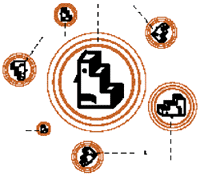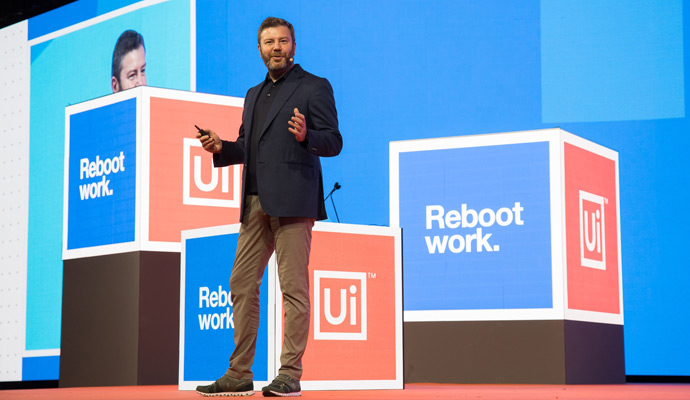Here Comes Front-office Automation
(originally published by Booz & Company) Using technology to automate business processes can increase efficiency and reduce costs, but these returns pale in comparison to what can be achieved when technology becomes the catalyst for changing long-entrenched practices.
Using technology to automate business processes can increase efficiency and reduce costs, but these returns pale in comparison to what can be achieved when technology becomes the catalyst for changing long-entrenched practices.
Over the past five years, many corporations have begun using a new group of software applications to automate their interactions with customers. Some have seen impressive returns on their investments. But the big returns may be yet to come as companies increasingly learn to use these programs as strategic tools.
Wall Street calls these new programs front-office software, to distinguish them from traditional back-office applications like general ledger, human resources and manufacturing management. The term "front-office" is almost intentionally vague, encompassing sales force automation, call-center management, product and price configuration tools, and help-desk applications. What these programs have in common is an outward focus, aiming to improve dealings with customers, as opposed to the back-office focus on streamlining in-house operations.
Although back-office software companies -- like SAP AG, the Baan Company NV and Peoplesoft Inc. -- remain far larger, the front-office vendors have formed the fastest-growing segment of the software industry in recent years, at times propelling the stock prices of companies like Siebel Systems Inc., the Vantive Corporation and Clarify Inc. to dizzying multiples of earnings per share. Studies by the Gartner Group and the International Data Group project that the front-office market will grow from about $600 million in 1997 to $3 billion by the year 2000; other estimates are even higher.
The makers of front-office applications claim these programs are "top-line generators," meaning that they can actually lift revenues by increasing salespeople's closure rates, improving customer retention and creating new venues in which sales can occur. As more products become commoditized, front-office programs offer corporations a fresh opportunity to differentiate themselves through their marketing, sales and service organizations. The programs let large companies personalize sales and service relationships the way that small ones always could.
The payoffs can be immense and immediate: one large software company saw an almost instant $10 million a month in additional revenue simply by automating contract renewals.
 But large returns imply large risks, and the front-office software market has its share. This is still a wide-open market, filled mostly with tiny, often privately held companies whose survival is by no means assured. Even some of the largest companies, which have met or passed $100 million in sales, remain immature and vulnerable to a wave of consolidation just beginning to sweep the industry. Some of these companies may be strained serving a large customer, and anecdotal accounts of failed deployments abound.
But large returns imply large risks, and the front-office software market has its share. This is still a wide-open market, filled mostly with tiny, often privately held companies whose survival is by no means assured. Even some of the largest companies, which have met or passed $100 million in sales, remain immature and vulnerable to a wave of consolidation just beginning to sweep the industry. Some of these companies may be strained serving a large customer, and anecdotal accounts of failed deployments abound.
Another set of risks is cultural. Employees may cling to old, familiar processes no matter how much the new ones are improved. Salespeople may resent the intrusion of technology in their daily routine, and no sales-force automation tool is productive if the people in the field refuse to use it. Most of these products are surprisingly easy to use, with graphic user interfaces that speed the learning curve, but companies still shortchange training at their peril. Dealers and distributors may feel threatened by programs that forge closer bonds between manufacturers and end users.
But no company can afford to sit idly by while its competitors adopt these tools. Most new technologies go through a transition period, when the market moves from a few early adopters who will try anything to the legions of pragmatists who hold back until they've seen that a solution really works. For front-office software applications, that transition is happening now.
Until recently, "most of the process re-engineering and technology investment has been back-office-focused on reducing costs and increasing efficiency," said Ajay Agarwal, vice president of sales and marketing for the Trilogy Development Group, a front-office company based in Austin, Tex. "Sales and marketing have largely been ignored, from both a process focus and a technology focus. But after all the downsizing and cost-cutting, companies are realizing they can only grow earnings so much without growing revenues," he said. "When you think about the top line, a focus on customers, sales and marketing is critical."
Companies began applying computers to back-office functions like general ledger more than 30 years ago and began shifting to packaged applications, like SAP's R-3, for these tasks about 10 years ago. With the broad acceptance of these programs, and the uniformity of the processes they have encouraged, back-office efficiency is no longer a place to gain competitive advantage.
"To reduce your costs and have better processes on the back end today is a 'so what,'" said Klaus Besier, president and chief executive of CWC International Inc., a front-office company based in Minneapolis, and a former senior SAP executive. "If every company is using SAP, the question is: What is the competitive advantage to me? Not much. The only differentiator you have left is in the sales and marketing arena," he said. "Drive the top line and market share."
CWC and Trilogy both produce configurators, programs that provide a simple, and easily customized, graphic interface to a sophisticated database that can keep track of all the multiple components, features and pricing of a broad set of products. With one of these tools on a laptop computer, or increasingly on a corporate site on the World Wide Web, salespeople can tailor a product to meet a customer's specific needs -- interactively and in real time -- without perusing paper manuals or making telephone calls back to base. The program knows which feature sets are compatible and which are not, and how to price them. In many industries, the growing complexity of products makes configurators a powerful tool for competitive advantage.
"The effect was to give all our knowledge to the salesman to configure and build a solution with the customer," said Bruno Chazalette, manager of sales and marketing for the commercial truck division of Renault V.I. in Paris, which is using CWC's tools in direct sales and through private dealers. "It puts pressure on the organization to meet customers' needs. Before, we sold what was in stock; now we sell a customized truck to every customer," he said. Renault has seen a measurable improvement in quality of orders and a reduction in time to market since implementing the program, he said.
In many industries, pricing complexity is driving the adoption of configuration tools. In the hospital and surgical supplies market, for example, pricing is set by manufacturers and differs by customer based on volume, but products are delivered by distributors who often depend on manufacturer's rebates for their profit. The Allegiance Healthcare Corporation, a hospital supplies distributor in McGaw Park, Ill., recently deployed a system produced by Trilogy, interfaced with its own SAP system, to improve the alignment of pricing between itself, its vendors and its customers.
Instead of depending on sales representatives to notify customers of new prices, the Trilogy system notifies them directly by E-mail or fax. "Because price fioats around so much, we used to have a lot of disputes," said Jeff Blair, Allegiance's vice president of pricing and contracting. "Direct notification allows us to reduce the amount of our receivables that is in dispute. When we went into dispute in the past, we had very little historical data, so we had a difficult time collecting. Now we go in in a much stronger position," he said. "We now build pricing off a platform that's more customer-facing."
Today's customers are more sophisticated than in the past, and they come to a sales call with a greater understanding of their own needs. Sales-force automation tools, like configurators, or Siebel's opportunity-management programs help the salesperson meet the customer's expectations. Siebel's program lets field salespeople record and track customer interactions and then present their data through a central database so that the knowledge is available to the entire enterprise. "The salesman becomes a much more consultative, value-added person than just someone who's trying to get you through a sales cycle," said Patricia House, executive vice president and chief operating officer of Siebel, which is based in San Mateo, Calif.
Front-office programs are also a way to share knowledge in a sales or service organization, knowledge that might have been the domain of mid-level managers whose positions were eliminated in the downsizing of the past few years. "A lot of questions used to be answered by the hierarchy," said Lawrence Garlick, chairman and chief executive of the Remedy Corporation. "In today's fiat organizations, your boss knows only slightly more than you do," he said. Remedy, based in Mountain View, Calif., produces help-desk software, originally used to track internal service issues, largely computer problems, but now increasingly applied to customer service.
For many companies, the biggest problem addressed by front-office software is the legacy of incompatible data systems that has prevented them from presenting a unified face to customers. Some of these systems may have been inherited through acquisitions, some adopted as new business units formed to offer new products. The problem has only worsened in the era of personal computers and distributed computing, as systems have often been adopted on a departmental basis. These systems cannot share data easily, and the information in them is often contradictory, and thus invalid.
These problems affect companies large and small, old and young. Datastream Systems Inc., a fast-growing software company in Greenville, S.C., had more than 20 disparate databases for marketing, sales and customer support. "We had databases all over the company to offer support," said Will McCuen, Datastream's director of corporate systems. "We never could trust or have confidence in that data."
Datastream replaced those numerous systems with one program from Onyx Software Inc., of Bellevue, Wash., that combines sales-force automation with service and support tools. "Now we can track the success of a campaign, what really takes place when a lead converts to a sale," Mr. McCuen said.
Prudential Investments, based in Newark, N.J., faced a typical situation. Prudential often sold multiple products, like insurance and mutual funds, to its large corporate customers, but these products had separate sales forces, with distinct, unconnected and incompatible data systems.
"The software systems we had could not talk to each other, and we had no way of commonly identifying a customer across the different systems," said Subramaniam Kumar, a vice president for Prudential's institutional asset-management division. "The process of tracking each step of selling to these customers was not handled at all," he said.
Prudential now has 120 of its people connected to a system from Onyx. "When somebody needs to know about a customer, you do not need to call multiple departments and wait weeks for a response," Mr. Kumar said. "You just type in the name of the customer, and the information is at your fingertips. Information is power," he said.
As such, information can be the key to customer retention. For a company like ADP Employer Services, which provides payroll and human-resource outsourcing, more effective customer service is a matter of survival. Like Prudential, ADP recently deployed front-office software, in its case from Clarify, to link disparate information systems among its various divisions.
"The bar keeps getting raised in client service," said Howard Koenig, corporate vice president of operations and client services for ADP, which is based in Roseland, N.J. "People don't compare us to other payroll companies. They compare us to companies where they get world-class service, like Federal Express or Fidelity," he said. "You need technology to meet the clients' expectations. You can't tell people I'll look into it and get back to you in three days," he said. "They would laugh at you."
Some newer companies, especially those that may have come of age in the last five years along with the front-office software suppliers, say they could not execute their business model without these programs. "You can't scale a company in the service business without having these levels of automation," said Bob Rouse, executive vice president of engineering systems and operations for Intermedia Communications, a telecommunications services company based in Tampa, Fla., that relies on its front-office software to keep track of all customer interactions.
Front-office software systems are typically less costly and pervasive than back-office deployments, but they are still significant investments, often measured in the multiple millions of dollars. And the industry is full of dark tales from companies about competitors' products deployed but never used. Many companies, however, report a meaningful return on their investment, often in a very short time.
Novell Inc., the networking software company based in Provo, Utah, provides one dramatic example. Novell has traditionally sold many of its software programs on an annual contract basis, but, because the sales went through multiple distribution channels and because of Novell's history of growth by acquisition, the data on these contracts were stored in multiple, often incompatible systems, and renewals sometimes fell through the cracks. Now contract renewals all reside on a single database using a front-office program from Scopus Technology, an Emeryville, Calif., company acquired by Siebel in March.
"We believe this is $20 to $30 million a quarter in additional revenue for us," said Eric Schmidt, Novell's chairman and chief executive. "The payback is like yesterday. Anything you can do to increase revenues is the first thing to look at. Anything you can do to increase efficiency is the second thing," he said.
 Any company that has completed a major back-office deployment knows that these systems not only prompt business process re-engineering but tend to shape the way those processes are changed in very definite and predetermined ways. Front-office vendors as a group insist their programs are more fiexible and can be customized to suit a buyer's existing processes, but they also say the greatest value comes when their programs are the enabling tool to execute long-needed process changes. Users acknowledge, however, that the programs do embody assumptions about best practices, and a company must carefully evaluate these programs to make sure their implicit directions are compatible with the company's own internal goals.
Any company that has completed a major back-office deployment knows that these systems not only prompt business process re-engineering but tend to shape the way those processes are changed in very definite and predetermined ways. Front-office vendors as a group insist their programs are more fiexible and can be customized to suit a buyer's existing processes, but they also say the greatest value comes when their programs are the enabling tool to execute long-needed process changes. Users acknowledge, however, that the programs do embody assumptions about best practices, and a company must carefully evaluate these programs to make sure their implicit directions are compatible with the company's own internal goals.
"When you buy into one of these systems, you're buying into a management methodology as well," said Mr. Schmidt, who before joining Novell was chief technology officer at Sun Microsystems Inc. "They have internal business logic, whether the vendors tell you that or not, with a specific bias."
 At Novell, which is in a turnaround effort after several years of sagging sales and shrinking market share, Mr. Schmidt said he felt the "plain vanilla" business processes imposed by these programs would likely improve on the clearly dysfunctional processes they replaced. "As long as it's vanilla, at least you know somebody else has used it," he said. But he went further, adding that greater standardization of processes among these programs would benefit most companies. "What we see today are tremendous differences in business processes that make no sense; it's full employment for mid-tier M.B.A. people," he said. "Our economy is better served by more standardized business processes, at least by company type."
At Novell, which is in a turnaround effort after several years of sagging sales and shrinking market share, Mr. Schmidt said he felt the "plain vanilla" business processes imposed by these programs would likely improve on the clearly dysfunctional processes they replaced. "As long as it's vanilla, at least you know somebody else has used it," he said. But he went further, adding that greater standardization of processes among these programs would benefit most companies. "What we see today are tremendous differences in business processes that make no sense; it's full employment for mid-tier M.B.A. people," he said. "Our economy is better served by more standardized business processes, at least by company type."
One can recognize the inherent biases of front-office programs by having some knowledge of the vendors' histories. Although most of the software companies have moved toward offering suites of applications that cover the entire front-office spectrum, nearly all of them started with a single program, and the orientation of that program still informs each product's internal logic.
Thus Siebel, which began with a tool for automating contact management for large field sales organizations, is still based on "the notion that you can use technology to make salespeople more effective," in the words of Ms. House, its chief operating officer. Yet the company had already created its own customer service application and, with the acquisition of Scopus, has now moved further into the realm of call-center management.
Clarify and Vantive, by contrast, began with call-center management, supplying the software for the people answering all those 800-number calls, and only later moved into sales-force automation. Both companies view customers as assets to be managed, with a bias that superior service leads to greater customer retention and that retained customers generate more sales at lower costs than new ones do.
Call-center programs are similar to work-fiow management applications, but with a service bias. The idea is to capture, manage and track every interaction with a customer, from initiation to resolution. When a customer calls with a problem, the service person is instantly familiar with that customer's history, likes, dislikes and quirks. Most of the programs also provide a script, with specific details for different vertical markets, that guides service people through a call.
"We make sure that every problem posed by a customer is owned by one individual in the organization; we think that is key," said David A. Stamm, Clarify's founder and chairman. "If I own a problem, I better solve it or move it within four hours. Each person knows their role and has responsibility to see it through," he said.
 A former engineering executive at the Intel Corporation, Mr. Stamm polled Silicon Valley companies before starting Clarify, which is based in San Jose, Calif., to see why no publicly traded company had addressed developing packaged software applications for service automation. "The answer was the business processes were so different from company to company," he said. "You can't take college courses in sales and service; you can in all the engineering disciplines, materials management, accounting." Clarify's goal was to identify and build on those processes that companies had in common, while providing simple tools to customize its programs where they differed.
A former engineering executive at the Intel Corporation, Mr. Stamm polled Silicon Valley companies before starting Clarify, which is based in San Jose, Calif., to see why no publicly traded company had addressed developing packaged software applications for service automation. "The answer was the business processes were so different from company to company," he said. "You can't take college courses in sales and service; you can in all the engineering disciplines, materials management, accounting." Clarify's goal was to identify and build on those processes that companies had in common, while providing simple tools to customize its programs where they differed.
Tom Davenport, a professor at the University of Texas at Austin who has studied the sociology of computer systems, said the front-office applications are, as a group, more easily modified than their back-office counterparts. "They're not so comprehensive, so they don't dominate your life to the degree an enterprise system would," he said. "People have undoubtedly been forced into some sales or service processes they wouldn't have done otherwise. But these are areas that have not been very process-oriented, so it probably is a good thing for them to become more focused and measurable," he said.
So far, however, most companies have not used front-office applications to make fundamental changes, Mr. Davenport said. "The things most companies have done have been administrative. They haven't really penetrated the heart of the activity," he said. "These systems are theoretically capable of problem resolution and collaborative selling, but that requires a great degree of process re-engineering," he said. "You can use these things without changing your processes very much at all, but then you don't get a lot of value out of them either."
Vendors do not dispute Mr. Davenport's assertions, but they say that front-office applications are going through a natural transition, common to new information technologies. As with relational databases in the 1980's, companies are first using these new programs for simple transactional tasks, like tracking customer interactions, and will adapt them later for tactical purposes, like measuring the results of different promotional campaigns or incentive structures. Only a bold few have already begun to use them for strategy, like weighing the relative merits of different sales and service processes in a proactive way, and then executing those plans. Companies use the technology in the lowest-risk venues first.
And some risk aversion may be wise when dealing with a market still in fiux. Most analysts believe front-office software will follow the examples of countless other software applications, from word processors to electronic design automation, with two or three big players dominant, and smaller companies swept up in acquisitions or dying slowly for lack of sales. But this consolidation has just begun.
"It's been a very wide-open market, growing at such a rapid rate that even crummy companies can survive," said Brent Frei, president and chief executive of Onyx Software, based in Bellevue, Wash. "At some point, the industry analysts who write about this stuff have to start talking to real customers, not listening to marketing hype, and hold vendors' feet to the fire," he said.
The back-office companies are beginning to play a bigger role as well, integrating some front-office functions into their existing programs or offering new applications, through either internal development or acquisitions or a mixture of both. This process, which began with Baan's purchase of Aurum Software last year, accelerated in March with SAP's announcement of its sales-force automation solution, developed in collaboration with Kiefer & Veittinger GmbH of Mannheim, Germany, which is now 80 percent owned by SAP. The Oracle Corporation, J.D. Edwards Inc. and Peoplesoft have also begun adding front-office capabilities to their back-office programs.
"We don't believe this stuff is stable," said Bobby Cameron, an analyst with Forrester Research Inc. in Cambridge, Mass. Customers face a difficult choice: "Companies can choose a suite from a number of leading vendors and accept the reality that their vendor will inevitably lag behind in important new capabilities. Adopting a pure best-of-breed approach gives users the exact functionality they want -- along with a never-ending integration, support and vendor management nightmare," he said.
Nevertheless, most customers still insist on buying the highest-performance applications from a number of vendors, rather than packaged suites, even with the added cost of integration and support. "Users never gave up their desire for 'best of breed,'" he said. "There will be a new role for systems integrators as portfolio assemblers, preselecting and assembling multi-vendor solutions and then supporting that," he said.
Still, the competitive advantages offered by these programs have prompted even technology-averse companies to make the leap. The explosion of interest in the Internet and the World Wide Web has been a further impetus. Although front-office software companies were no more clairvoyant about the Web than other software vendors, they have all been quick to seize upon it as a strategic opportunity by offering Web-based versions of their configuration tools or customer-support packages.
A Web-based program from Clarify is Toyota Motor Sales U.S.A.'s first application based on client/server technology, a systems architecture that distributes programs and data among multiple computers on a network and that most corporations began adopting in the late 1980's. "We felt it was important enough to make that leap," said Carole Pedriana, national manager of Toyota's New Era Information Technology. "We don't have many opportunities to deal directly with our customers, so we feel it is important enough to spend the money -- and, in this case, take the risk -- because it is new technology," she said.
The program will allow Toyota customers, for the first time, to have questions answered and problems addressed by the national sales and distribution organization either through their dealers or directly from the main office over the Internet.
Nevertheless, Toyota is proceeding carefully, stopping short of offering sales or fulfilling orders over the Web. "This is a very touchy subject," said Ms. Pedriana from her office in Torrance, Calif. "Our dealers have very strong feelings. They're very nervous about manufacturers actually getting involved in selling," she said.
Less conservative companies are proceeding as rapidly as they can and letting the cultural issues get resolved along the way. Some have been surprised to encounter resistance among employees or customers, and they have had to back up and offer new training and guidance to get constituents to buy into the new programs and processes.
"When you deploy these revolutionary systems, there is a bit of re-engineering that has to happen among the users of the system," said Mr. Kumar, of Prudential. "I thought users would be ready to use such a system, with such obvious benefits, but some were resistant to change," he said.
The most ambitious companies are already using these programs to sell to and service their customers in new ways, to offer new products and services and to expand into new markets. They are creating new business processes on the fiy, finding the best practices as they go.
"People now can think about doing things they never could before, and that will drive process change," said John Luongo, president and chief executive officer of Vantive, based in Santa Clara, Calif. "Technology can support sophisticated processes that in turn support strategies. But, fundamentally, the business leaders have to make the key decisions themselves."
Front-Office Case Study: Microsoft
Coping with incompatible legacy systems and inaccessible or conflicting data is by no means the exclusive domain of stodgy companies in moribund industries. By many measures, the Microsoft Corporation is the most successful company of the last two decades -- and obviously as technology savvy as any. But until recently its customer-tracking systems suffered from some remarkably common problems.
Some of the problems were as much political as technical because of the company's highly departmentalized structure. Brent Frei, a former Microsoft executive, now president of Onyx Software, recalls the difficulties the company faced when it began charging for customer service in the late 1980's.
"Customer-registration data was the property of marketing and was all outsourced to a mainframe in Chicago," he said. "Each department had a system to automate what they did," he said. Mr. Frei left in 1994 to found Onyx with two other Microsoft colleagues, but the company's systems complexity only grew.
"In 1995, we had 36 distinct, separate applications worldwide that provided incident tracking," said Mark Perry, Microsoft's general manager for enterprise technical support. All of these applications were homegrown, written by Microsoft's own programmers and, of course, with Microsoft's own programming tools to run on Microsoft's own operating systems and database software. Yet there were differences significant enough that the programs did not communicate with each other.
When Microsoft decided to replace its 36 homegrown applications for customer support with a single packaged solution, it settled on Clear Support from Clarify. Clarify was the choice at least in part because it ran on Windows NT, the Microsoft operating system, at a time when most competing products ran on Unix. But Mr. Perry said Clear Support also "provided a better match of features and functionality to our business requirements." And, he added, "it lowers our cost because we don't have to develop those features ourselves."
The deployment of Clarify's program at Microsoft went smoothly, but it nonetheless presented some unforeseen challenges. At that time, Clarify's largest installation was at Sybase Inc., the database company based in Emeryville, Calif., where 500 workers used the software, but Microsoft wanted to roll out the program to 2,000 users. "We underestimated the challenges of working with a vendor," said Mr. Perry. "We didn't want to be the 900-pound gorilla. We didn't want to put them out of business. But we wanted to deploy in six months. At the time, they looked at me and said 'huh?' Now that's normal," he said. Pressed, the company did manage to deploy within seven months. "They were very responsive," Mr. Perry added.
But Microsoft also underestimated the internal demands of such a large deployment. "We were almost a disaster; we were in desperation mode," Mr. Perry said. "We were moving as a company to supporting more and more corporate customers on Windows NT, but we were having a hard time supporting those customers on a global basis. So we basically sent a message out to our organization: 'Here's what we've done for you. We've decided not to build. We're going to buy a package and give it to you in six months,'" he said. "That was an expectation on which we couldn't deliver."
At that time, Microsoft's back-office applications were also largely homegrown; it has since become a major SAP customer. Clarify integrates easily with SAP, but meshing with the legacy systems was another matter. "We didn't anticipate the complexity of integrating that solution into our corporate infrastructure," Mr. Perry said. "To try to recover from some high-level expectations we knew we couldn't meet, we started cutting back on some efforts. The thing I cut, and it was a mistake, was end-user training," he said. "We were also going through and re-engineering our processes at the time. There were changes of workflow and process that we should have spent more time educating users on," he said.
Despite a rocky start, the Clarify system soon began to pay for itself. "We started to reap some of the benefits within the first six months," Mr. Perry said. "We were able, using the data from the Clarify system, to make decisions in a much better, more timely fashion. It allows us to empower people to make decisions," he said.
The program has helped overcome some of the geographic and departmental balkanization that had hindered customer support, Mr. Perry said. "In the past, we would change one geography or one application at a time. Today, we can make a change and within 24 hours replicate that change worldwide," he said.
Customer support has traditionally been a telephone-based operation at Microsoft, but with the explosive growth of the World Wide Web, more and more support calls are on-line. "These customers already have access to a lot of information, so typically their questions are more sophisticated," Mr. Perry said. "By hitting the Clarify system, we can often post a response back to the customer without that question ever reaching a human being."
Microsoft now has 3,000 of its employees using the Clarify system worldwide, primarily supporting corporate customers. The company is in the process of rolling out the system for consumer support as well, and expects to have 10,000 users by year end.
"Our goal," said Mr. Perry, "is to get to one program worldwide." ![]()
| Authors
Lawrence M. Fisher, lafish3@attbi.com, covered technology for the New York Times for 15 years and has written for dozens of other publications. Mr. Fisher, who is based in San Francisco, is a recipient of the Hearst Award for investigative journalism. |




